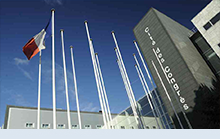 |
European Planetary Science Congress 2015
27 September – 02 October 2015
La Cité des Congrès, Nantes, France |
 |

|
MG2 Comparative auroral processes : from the solar wind to planets |
| Convener: Laurent Lamy | Co-Conveners: Aikaterini Radioti , Baptiste Cecconi , Japheth Yates |
|
Oral Program
/ Tue, 29 Sep, 09:00–12:37
/ Room Uranus
Poster Program
/ Attendance Tue, 29 Sep, 17:45–19:15
/ Poster Area
|
Auroral emissions have been detected from all explored magnetized planets of the solar system and several of their satellites. Such powerful electromagnetic radiations result from a complex interplay between the sun, the solar wind, the planetary magnetosphere and its moons, the planetary ionosphere and the rings. Auroral processes cover a wide range of wavelengths (from radio to X-rays) with various generation mechanisms, and form a set of valuable diagnostic to remotely probe space plasmas from upper (exo)planetary atmospheres to the heliosphere, magnetosphere-ionosphere coupling etc. and form the basis of modeling studies such as global circulation models.
This session welcomes contributions on the most recent results obtained from the large set of planetary and heliospheric observations provided by numerous recent space missions (Cassini, Cluster, STEREO, JUNO, HST, XMM/Chandra...) or older ones (Voyager, Galileo, Wind, Ulysses…) and ground-based observatories (IR and radio telescopes) as well as modeling and theoretical developments, with a special attention for multi-spectral approaches and comparative analysis. A particular focus will be given to recent observing planetary campaigns. We also encourage contributions regarding future prospects in the frame of upcoming missions to Jupiter (JUNO, JUICE), Mercury (Bepi-Colombo) and ongoing projects to Uranus, Neptune and the Earth. This session aims at favouring discussions between terrestrial, solar system and extrasolar system communities.
